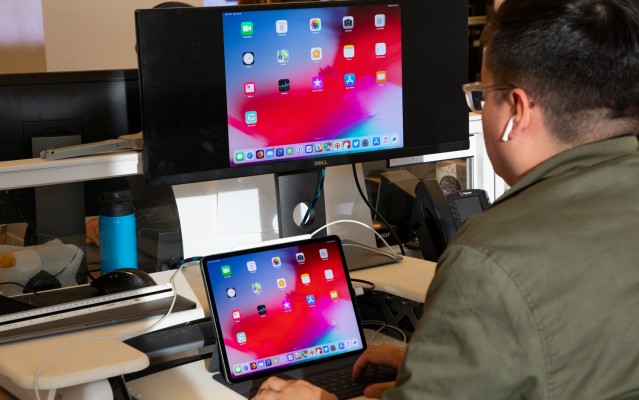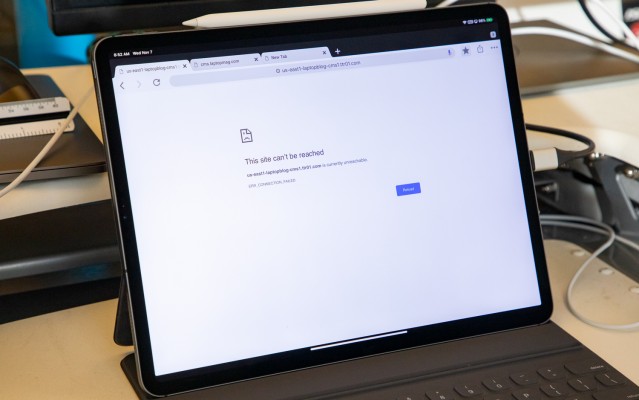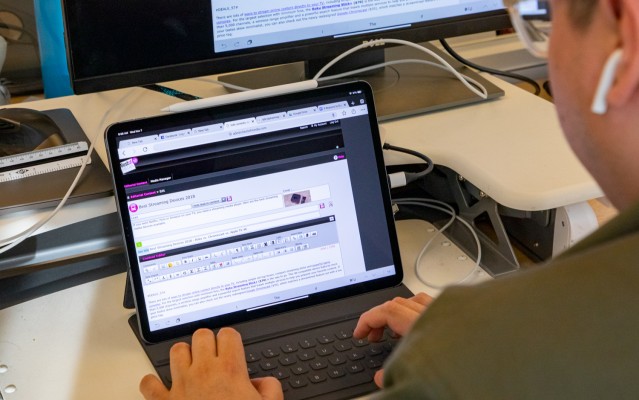Can the iPad Pro Replace Your Laptop? Here's What 3 Pros Think
Apple really wants you to think of the iPad Pro as the device that will kill the laptop, but the Not-So-Little Tablet That Could might not be there yet. Sure, Apple's blessed its latest iPad Pros with blindingly fast A12X processors, but iOS is still far from a fully fledged desktop-class operating system, thanks to some of the decisions Apple made to keep the slate safe and malware free.
I've spent two days trying to rely on the new iPad Pro as my primary computer. And while I was able to write most of this article on the new 12.9-inch tablet, I hit some pretty substantial roadblocks. Here's how the iPad Pro worked out as a laptop replacement for me, as well as for three professionals who use (or, at least, tried to use) Apple's slate on a day-to-day basis.
Getting started
I intended to spend a whole workday using only the iPad, but I hit my first roadblock with my first task of the morning. All I needed to do was update our Best Kindles and E-Readers page, but multiple on-screen buttons that I needed in our web-based publishing system failed to appear in Safari, Chrome or Firefox Focus.
Why the tablet's browsers, which all run Apple's own WebKit rendering engine, failed me was a mystery. Sure, the content management system (CMS) we use isn't modern, but those buttons always appear when I use the web browser on any desktop operating system.
And that one failure is just the tip of the iceberg. My job requires the use of browser plug-ins, and because iOS is made for browsing only in Apple's approved way — without any plug-ins or extensions — my productivity would be handicapped using the iPad's browsers.
For my next assignment, I successfully composed a new article for Laptop Mag in Bear, my preferred text editor. But I couldn't open the other CMS we use for publishing content to this website. Even though I was able to wrangle OpenVPN into connecting me to the VPN network we use for that CMS, pages refused to load in any web browser.
Even if I had gotten through to any of those CMS pages, though, I'd have hit another annoyance. iOS doesn't support rich text, so I'd have to export via HTML, something that not every text editor does (Google Docs doesn't). And while my beloved Bear text editor does export via HTML, it exports only HTML files and doesn't let you place HTML code for a document onto your clipboard.
Sign up to receive The Snapshot, a free special dispatch from Laptop Mag, in your inbox.
MORE: Best Apple Laptops
Later that day, I opened Google Docs on the iPad to review edits to an article. Annoyingly, I ran into the same Google Docs flaw I've seen on the iPhone too many times before: repeated app crashes.
I'm not sure why Google Docs failed on me as I repeatedly clicked on Accept for changes, but Google Docs kept bringing me back to the home screen. Oh, and don't even try to open a Google Doc in a mobile web browser on iOS — that includes Google's own Chrome. The document just shows up as one uneditable page of text.
Outside of the office, the iPad felt a little more capable of replacing a laptop. I could split the slate's large screen between Safari and Things 3 (my productivity app of choice) to plan my upcoming trip to Los Angeles. And that huge panel proved a great way to watch everything from YouTube videos to the climactic fight between T'Challa and Killmonger in Black Panther.
But then I got an email alerting me of a new song released by the musician/pro wrestler Rocky Romero. After I bought the song off Bandcamp, I got a message saying that the device I was using didn't support downloads, so I couldn't add the tune to my iCloud Music Library. My alternative? Listen in the Bandcamp app, which still isn't optimized for the iPad. Had I been on a laptop, the MP3 file I bought would have simply appeared on my desktop.
The pros who work on iPad
When I put word out on Twitter asking to hear iPad success stories, I got an eye-opening answer from Sebastian Sanchez.
Working in logistics operations development, Sanchez said he was tired of lugging "laptops across America's airports for 10-plus years." He chose the 10.5-inch iPad Pro (2017) to be his new daily driver, because it has iCloud integration and he prefers "a lighter device that provided portability, reliability and battery performance."
In that sense, I completely get the allure of the iPad Pro, which lasted 13 hours and 14 minutes on the Laptop Mag Battery Test. Also, iOS's stability and security beat practically every other platform's.
As for Sanchez's must-have apps, he rattled off Slack, Excel, Mail, Skype for Business, PowerPoint, Notes and Files, specifying that he uses iCloud, Dropbox, Box and OneDrive with Files. He's not afraid of using dongles either, carrying around an HDMI connector for his keynotes.
MORE: The iPad Pro and MacBook Air Need to Merge. Now
Sanchez also ran into one of the awkward moments that still bothers me: "I did have to get used to not having a mouse anymore," he said. It "took about a day or so to [get] rid of that gesture of looking for the mouse next to the screen." But it seems as if he made it through successfully. "I love the experience of the smart keyboard," he said.
When I asked Sanchez if he had a hard time moving his workload to the iPad, he explained why he succeeded (and possibly why I failed). "I realized how much I already did with my iPhone prior to owning my iPad," he said, and this made switching from a laptop to the iPad a "very smooth transition," with the slate involving "pretty much [the] same gestures and experience, [but] with a larger screen."
But while his 2017 iPad Pro has served Sanchez well, he said he's "definitely updating" to the 2018 iPad Pro, as that will mean the same experience but with the Face ID that he enjoys on his iPhone XS.
iPad Pros and cons
But for every success, there's a story like the one I heard from Bradley Chambers, the director of IT at the Brainerd Baptist School in Tennessee, who also blogs at 9to5Mac.
Remember how Sanchez said it was easy to get used to the iPad because of what he does on his phone? Chambers told me that's not a positive: "I love iOS, but iOS on the iPad is basically a blown-up version of the iPhone OS. Yes, there are some things, like multitasking, that are iPad-only, but it's not enough."
An iPad devotee who's "been using it since Day 1," Chambers told me, "there are just still things that are faster on macOS. If Windows and Google have figured out how to make a single device for tablet and desktop computing, why can't Apple?"
Chambers bristled at the iPad Pro's starting price of $799 before accessories. Because while that iPad Pro is really pretty and its display is sharp and its new Pencil is great, Chambers said, "hardware doesn't matter if it can't even run Google Docs in the web browser," echoing my own complaints from earlier.
The job-specific limitations I came across hit Chambers, too, as he said, "There are things like being a web-content administrator (for my school) that are nearly impossible to do on iOS." And those rare occasions when you can make it work? Chambers said, "Even if they are possible, they might take twice as long."
Why not use both?
The biggest iPad-first device user I know is Myke Hurley, co-founder of the Relay FM podcast network and my wrestling-podcast partner. Hurley described his time with the iPad as "an on-again, off-again relationship from the very beginning."
As a self-described "avid fan of pen and paper," Hurley came back to the iPad (the first 12.9-inch version) when the Apple Pencil was first announced, in 2015.
The combination of iOS's split-screen multitasking, the large screen, the Smart Keyboard and the Apple Pencil provided Hurley with "the full package that I didn't know I needed. I was an immediate fan."
MORE: 7 Reasons to Buy and the New iPad Pro (and 3 Reasons to Skip)
He said he loves the iPad Pro for "a lot of administration and communication work. ... I write. I send messages to people. I handle email. and social media." But that's not his whole job. And so he's not full time on Apple's tablet.
Because of the limitations in iOS, the only things he doesn't do on the iPad are recording and editing podcasts. According to Hurley that means "over half of my duties for my business are conducted solely on the iPad Pro," though "the actual time spent on these devices is different, purely because podcast production is a time-intensive affair."
Hurley's excitement for the future of iOS stems from Shortcuts, which he called "a big deal." He said, "it's helping bridge more and more gaps between applications and inside of the operating system itself."
What's left for Apple to add?
Hurley said Apple is "closer than they have ever been" to perfecting iOS, adding that he "cannot see any low-hanging fruit when it comes to the hardware side of things."
He added that "it's just a case now of seeing iOS 13 take advantage of the hardware gains."
Sanchez also has a wish list: "Excel for iPad could include very important functions from the desktop version, by adding the ability to create pivot tables and more-sophisticated charts." He said he'd also like native, FaceTime-based support for sharing the iPad screen via FaceTime.
To solve his job-specific woes, Chambers said he'd need the "full desktop version of Safari and ... trackpad/mouse support" added to the iPad.
I'm inclined to agree with Chambers on what the iPad version of iOS needs. On top of his suggestions, I'd love for the next version of iOS to redesign the layout of the home screen and its command center to fit the slate's larger screen. Until that happens, the iPad's home screen will look awkward, with a 4 x 5 grid of icons and a dock that don't quite look right together.
Things look even weirder with the iPad Pro plugged into a desktop monitor, which only mirrors the screen. If the iPad could expand to a second screen that fits the external display, and not appear with giant black bars on its left and right sides, it wouldn't look janky.
If Apple thinks users need to be protected from the dangers of a real web browser, the company could hide such an option behind a system preference that included a warning. An Apple Pro mode — what normal Windows 10 is without S Mode — could go a long way toward making me consider buying an iPad Pro for myself.
Credit: Laptop Mag
Henry was a contributing writer at Laptop Mag. He penned hundreds of articles, including helpful how-tos for Windows, Mac, and Gmail. Henry has also written about some of the best Chromebooks, and he has reviewed many Apple devices, including various MacBook Air laptops. He is now a managing editor at our sister site Tom's Guide, covering streaming media, laptops, and all things Apple.




